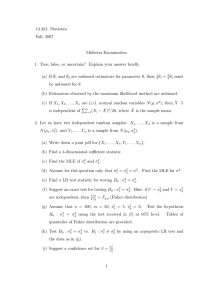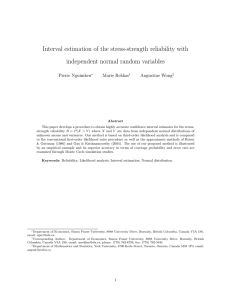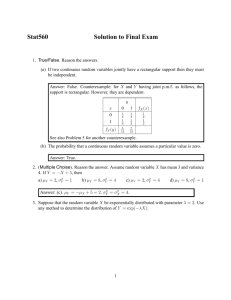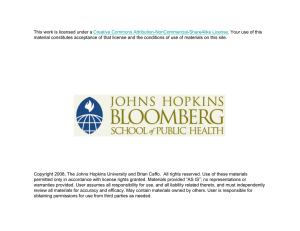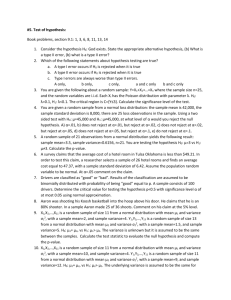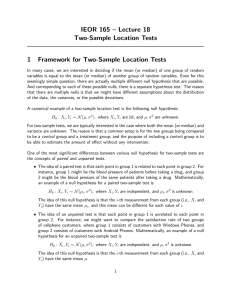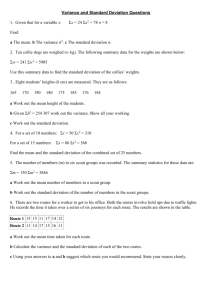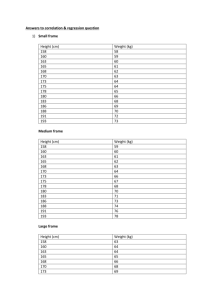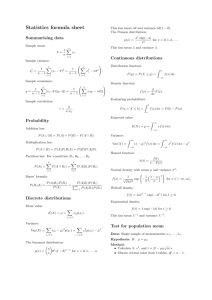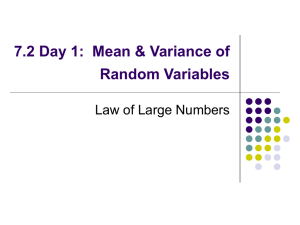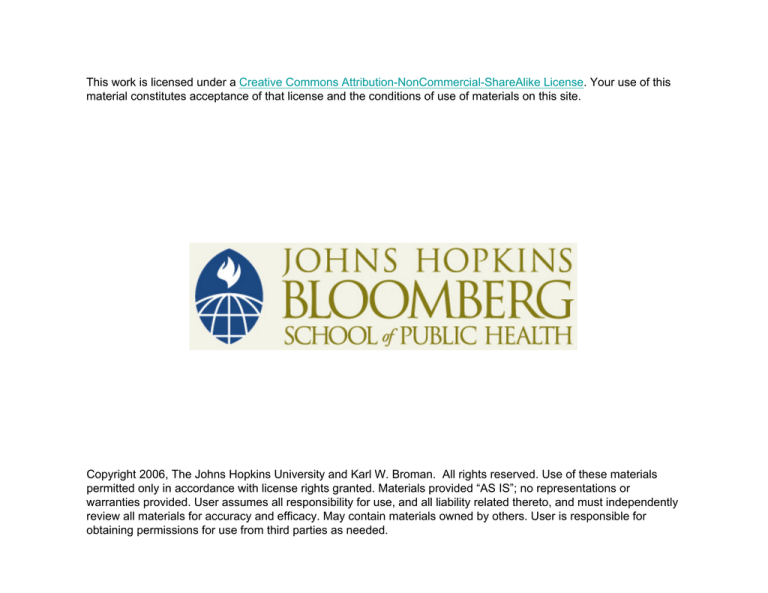
This work is licensed under a Creative Commons Attribution-NonCommercial-ShareAlike License. Your use of this
material constitutes acceptance of that license and the conditions of use of materials on this site.
Copyright 2006, The Johns Hopkins University and Karl W. Broman. All rights reserved. Use of these materials
permitted only in accordance with license rights granted. Materials provided “AS IS”; no representations or
warranties provided. User assumes all responsibility for use, and all liability related thereto, and must independently
review all materials for accuracy and efficacy. May contain materials owned by others. User is responsible for
obtaining permissions for use from third parties as needed.
The sample mean and variance
Let X 1, X 2, . . . , X n be independent, identically distributed (iid).
• The sample mean was defined as
P
xi
x̄ =
n
• The sample variance was defined as
P
(x i − x̄)2
2
s =
n−1
I haven’t spoken much about variances (I generally prefer looking
at the SD), but we are about to start making use of them.
The distribution of the sample variance
If X 1, X 2, . . . , X n are iid normal(µ, σ 2)
then the sample variance s2 satisfies (n – 1) s2/σ 2 ∼ χ2n–1
When the X i are not normally distributed, this is not true.
Let W ∼ χ2(df = n − 1)
χ2 distributions
E(W) = n–1
df=9
var(W) = 2(n–1)
p
SD(W) = 2(n − 1)
df=19
df=29
0
10
20
30
40
50
The F distribution
Let Z1 ∼ χ2m,
independent.
Then
Z2 ∼ χ2n.
and
and assume Z1 and Z2 are
Z1/m
∼ Fm,n
Z2/n
F distributions
df=20,10
df=20,20
df=20,50
0
0.5
1
1.5
2
2.5
3
The distribution of the sample variance ratio
Let X 1, X 2, . . . , X m be iid normal(µx, σx2).
Let Y 1, Y 2, . . . , Y n be iid normal(µy, σy2).
Then
(m – 1) × s2x/σx2 ∼ χ2m–1
and
(n – 1) × s2y/σy2 ∼ χ2n–1.
Hence
s2x/σx2
∼ Fm–1,n–1
s2y/σy2
or equivalently
s2x σx2
∼
× Fm–1,n–1
s2y σy2
Hypothesis testing
Let X 1, X 2, . . . , X m be iid normal(µx, σx2).
Let Y 1, Y 2, . . . , Y n be iid normal(µy, σy2).
We want to test
H0: σx2 = σy2
Under the null hypothesis
versus
Ha: σx2 6= σy2
s2x/s2y ∼ Fm–1,n–1
Critical regions
• If the alternative is σx2 6= σy2, we
reject if the ratio of the sample
variances is unusually large or
unusually small.
• If the alternative is σx2 > σy2, we
reject if the ratio of the sample
variances is unusually large.
σx2
Ha: σ2x = σ2y
0.0
0.5
1.0
1.5
2.0
2.5
3.0
3.5
2.5
3.0
3.5
2.5
3.0
3.5
Ha: σ2x > σ2y
0.0
0.5
1.0
1.5
2.0
Ha: σ2x < σ2y
σy2,
• If the alternative is <
we
reject if the ratio of the sample
variances is unusually small.
0.0
0.5
1.0
1.5
2.0
Example
A
B
500
600
700
800
900
1000 1100 1200 1300
treatment response
Are the variances the same in the two groups?
Example
We want to test
H0: σA2 = σB2
Ha: σA2 6= σB2
versus
At the 5% level, we reject the null hypothesis if our test statistic, the ratio of the
sample variances (treatment group A versus B), is below 0.25 or above 4.03.
The ratio of the sample variances in our example is 2.14. We therefore do not
reject the null hypothesis.
F distribution df=(9,9)
0
1
s2A s2B
3
4
5
6
7
Confidence interval for σx2/σy2
Let X 1, X 2, . . . , X m be iid normal(µx, σx2).
Let Y 1, Y 2, . . . , Y n be iid normal(µy, σy2).
s2x/σx2
∼ Fm–1,n–1
s2y/σy2
Let L = 2.5th %ile and U = 97.5th %ile of F(m–1, n–1).
Then Pr[L < (s2x/σx2)/(s2y/σy2) < U] = 95%.
Thus Pr[(s2x/s2y)/U < σx2/σy2 < (s2x/s2y)/L] = 95%.
Thus, the interval ((s2x/s2y)/U, (s2x/s2y)/L)
is a 95% confidence interval for σx2/σy2.
Example
m = 10; n = 10.
2.5th and 97.5th percentiles of F(9,9) are 0.248 and 4.026.
(Note that, since m = n, L = 1/U.)
s2x/s2y = 2.14
The 95% confidence interval for σx2/σy2 is
(2.14 / 4.026, 2.14 / 0.248) = (0.53, 8.6)
How about a 95% confidence interval for σx/σy?
Blood coagulation time
T
avg
A
62 60 63 59
61
B
63 67 71 64 65 66
66
C
68 66 71 67 68 68
68
D
56 62 60 61 63 64 63 59
61
64
Diet A
Diet B
Diet C
Diet D
Combined
56 57 58 59 60 61 62 63 64 65 66 67 68 69 70 71 72
Coagulation Time
Notation
Assume we have k treatment groups.
nt
number of cases in treatment group t
N
number of cases (overall)
Yti
response i in treatment group t
Ȳt·
average response in treatment group t
Ȳ··
average response (overall)
Estimating the variability
We assume that the data are random samples from four normal
distributions having the same variance σ 2, differing only (if at all)
in their means.
We can estimate the variance σ 2 for each treatment t, using the
sum of squared differences from the averages within each group.
Define, for treatment group t,
St =
nt
X
(Yti − Ȳt·)2.
i=1
Then
E(St) = (nt – 1) × σ 2.
Within group variability
The within-group sum of squares is the sum of all treatment sum
of squares:
XX
SW = S1 + · · · + Sk =
t
(Yti − Ȳt·)2
i
The within-group mean square is defined as
S1 + · · · + Sk
SW
MW =
=
=
(n1 – 1) + · · · + (nk – 1) N − k
− Ȳt·)2
N−k
PP
t
i (Yti
It is our first estimate of σ 2.
Between group variability
The between-group sum of squares is
SB =
k
X
nt(Ȳt· − Ȳ··)2
t=1
The between-group mean square is defined as
SB
=
MB =
k−1
It is our second estimate of σ 2.
That is, if there is no treatment effect!
P
− Ȳ··)2
k−1
t nt(Ȳt·
Important facts
The following are facts that we will exploit later for some formal
hypothesis testing:
• The distribution of SW/σ 2 is χ2(df=N-k)
• The distribution of SB/σ 2 is χ2(df=k-1)
if there is no treatment effect!
• SW and SB are independent
Variance contributions
XX
t
2
(Yti − Ȳ··) =
X
2
nt(Ȳt· − Ȳ··) +
t
i
XX
t
(Yti − Ȳt·)2
i
ST
=
SB
+
SW
N–1
=
k–1
+
N–k
ANOVA table
source
sum of squares
df
mean square
between treatments
SB =
X
k–1
MB = SB/(k – 1)
SW =
XX
(Yti − Ȳt·)2
N–k
MW = SW/(N – k)
(Yti − Ȳ··)2
N–1
nt(Ȳt· − Ȳ··)2
t
within treatments
t
total
ST =
i
XX
t
i
Example
source
sum of squares
df
mean square
between treatments
228
3
76.0
within treatments
112
20
5.6
total
340
23
The ANOVA model
Yti = µt + ti
We write
Using
τt = µ t − µ
with
ti ∼ iid N(0,σ 2).
we can also write
Yti = µ + τt + ti.
The corresponding analysis of the data is
yti = ȳ·· + (ȳt· − ȳ··) + (yti − ȳt·)
Hypothesis testing
We assume
Yti = µ + τt + ti
with
ti ∼ iid N(0,σ 2).
[equivalently, Yti ∼ independent N(µt, σ 2)]
We want to test
H0 : τ 1 = · · · = τ k = 0
versus
Ha : H0 is false.
[equivalently, H0 : µ1 = . . . = µk]
For this, we use a one-sided F test.
Another fact
It can be shown that
2
E(MB) = σ +
2
t n t τt
P
k–1
Therefore
E(MB) = σ 2
if H0 is true
E(MB) > σ 2
if H0 is false
Recipe for the hypothesis test
Under H0 we have
MB
∼ Fk – 1, N – k.
MW
Therefore
• Calculate MB and MW.
• Calculate MB/MW.
• Calculate a p-value using MB/MW as test statistic, using the
right tail of an F distribution with k – 1 and N – k degrees of
freedom.
Example (cont)
H0 : τ1 = τ2 = τ3 = τ4 = 0
Ha : H0 is false.
MB = 76, MW =5.6, therefore MB/MW = 13.57. Using an F distribution with 3 and
20 degrees of freedom, we get a pretty darn low p-value. Therefore, we reject the
null hypothesis.
F(3,20)
MB MW
0
2
4
6
8
10
12
14
The R function aov() does all these calculations for you!
Now what did we do...?
62
60
63
59
63
67
71
64
65
66
68
66
71
67
68
68
64
56
62
64
60
64
61
= 64
63
64
63
59
64
64
64
64
64
64
observations
yti
Vector
Y
Sum of Squares
98,644
D’s of Freedom
24
64
64
64
64
64
64
=
=
=
=
−3
64
64
−3
64
−3
64
+ −3
64
64
64
64
grand average
ȳ··
A
98,304
1
1 −3 0 −5
−3
−3
−1 1 −2 1
−3
2 5 3 −1
−3
+ −2 −2 −1 0
−1 0 2
−3
0
0
3
−3
2
−3
−2
−3
2
2
2
2
2
2
4
4
4
4
4
4
+
+
+
+
treatment deviations
ȳt· − ȳ··
T
228
3
+
+
+
+
residuals
yti − ȳt·
R
112
20

